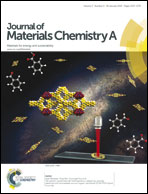ZnxCd1−xS/bacterial cellulose bionanocomposite foams with hierarchical architecture and enhanced visible-light photocatalytic hydrogen production activity†
Abstract
Visible-light photocatalytic H2 production by water splitting is of great importance for its promising potential in converting solar energy to chemical energy. ZnxCd1−xS-based systems are intrinsic visible-light photocatalysts with appropriate electronic band structure and negative reduction potential of photoexcited electrons; however, the H2 evolution rate is far from satisfactory. A common strategy for improving the photocatalytic activity includes the incorporation of expensive cocatalysts such as noble metals and graphene. Here, we report, for the first time, that high visible-light photocatalytic H2 production activity can be achieved by organizing ZnxCd1−xS nanoparticles into the hierarchical architecture of bacterial cellulose (BC). This is achieved by templated mineralization and ion exchange/seeded growth. The bionanocomposite foams of ZnxCd1−xS/BC are flexible, monolithic and hierarchically porous. The optimized Zn0.09Cd0.91S/BC exhibits a high H2 evolution rate of 1450 μmol h−1 g−1 and an excellent apparent quantum efficiency of 12% at 420 nm. The monolithic nature of ZnxCd1−xS/BC makes catalyst recovery and recycling possible. The current work manifests that the integration of intrinsic chemical properties with multilength scale structural hierarchy affords performance optimization.


 Please wait while we load your content...
Please wait while we load your content...